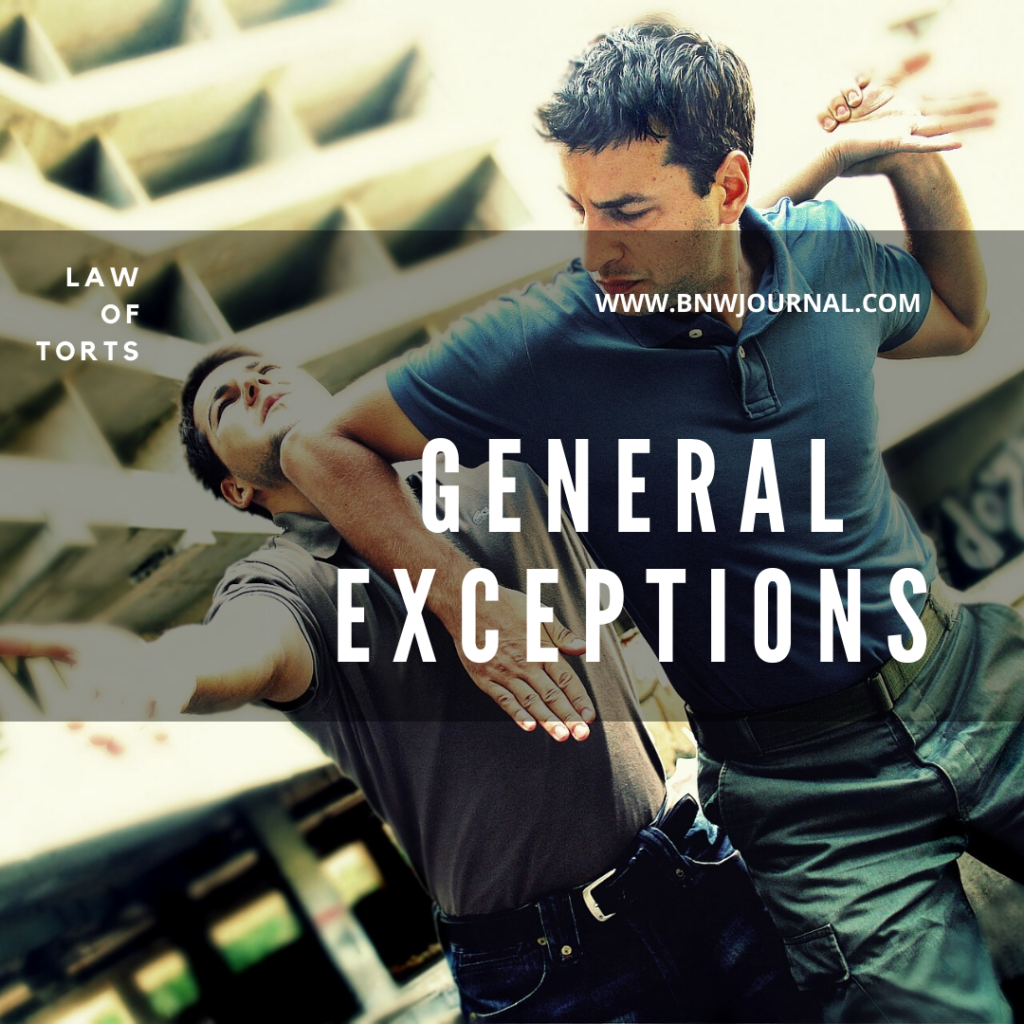![]()
Introduction
General exception in law of torts, quite popularly as defences or justification are a collection of excuses undertaken to escape liability in the law of torts. Most of these help in getting out in onto while for rest certain criterion needs to be fulfilled. Effectively these can be addressed ‘as the rules of immunity which limit the rules of liability’[1]. There are various conditions which one present will prevent an act from being wrongful which in their absence would be wrong. Under these conditions, an act is to be excuse and whenever an act is in general to be wrongful it is assume that no such qualifying condition exist these justifications or exceptions from civil liability for acts prima facia wrongful or based principally upon public grounds. These defences are:
- Statutory authority
- Private defence
- Inevitable accident
- Act of God
- Necessity
- Volenti non fit injuria- leave and license
- The wrongdoer is the plaintiff

Statutory Authority
The defence of Statutory authority operates upon the principle of authorization of liability because if the legislature authorises the doing of an act (which if unauthorised would be wrong) no action can be maintained for that act, on the ground that no court can treat that as a wrong[2]. Consequently the person who has sustaine a loss by the doing of that act is without remedy. Unless so far as the legislature has thought it proper to provide for compensation to him. In a nutshell, the philosophy behind the statutory immunity is that the lesser private right must yield to the greater public interest[3]
Private Defence
Private defence is essentially a right to defend; own property, person, possessional things against an unlawful harm. This defensive action or right may even be exercise in respect of one’s wife or husband or parent or child or even a master or servant. However in the court of law for this defence to exist it needs to prove that:
- There was a necessity to act upon &
- The defensive action is take against an immediate threat of physical harm.
Also, it should be considered that while defending oneself the force employed must not be out of proportion to the apparent urgency of the occasion[4], which would otherwise make up for an action in the law of torts.
Inevitable Accident
This is a classic defence take up by people who despite having taken enough care could not prevent an unfortunate set of events. Generally referred to as ‘Unavoidable accident’. The three basic ingredients which are always checked before providing the defence of inevitable accident are[5]:
- exercise of ordinary care
- ordinary caution
- ordinary skill
All causes of inevitable accident may be divide into two clauses
- Those which are occasion by the elementary forces of nature are you connect with the agency of the man and
- Those which have their origin either in the whole or in part in the agency of man. Weather in acts of commission or omission non-feasance or of misfeasance.
Act Of God
Act of God or in legal terms viz major is the term use for referring to things over which a man has no control whatsoever. Accelerated by nature, e.g. Tsunami and the floods following the aftermath are appropriate examples. In this a person has little to no resort in any way to mitigate the effects. However, the courts have always establish that the responsibility cannot be duck away if the person knew the ways to mitigate the damage in whatsoever amount.
Necessity
The defence of necessity goes by its name. Underlying the crux of this defence is the idea of the greater good for the prevention of greater harm. The defence of necessity can thus further be classified into:
- cases of public necessity &
- cases of private necessity[6]
The defence of public necessity is based on the maxim ‘Salus populi suprema lex’. This specific idea of ((the welfare of the people is the supreme law) public necessity is found on the implie consent or assent on the part of every member of society, that his welfare shall, in cases of necessity, yield to that of the community and that his property, Liberty and life shall under circumstances be placed in jeopardy or even sacrificed for the public good.
While private necessity has not been explore much but not left untouched. The Supreme Court in the landmark decision of Olga Tellis v. Bombay Municipal Corporation[7] explained that “under the law of torts necessity is a plausible defence which enables a person to escape liability because the acts complained of are necessary to prevent greater damage inter alia to himself. Here as elsewhere in the law of torts, a balance has to be struck between competing set of values”.
Volenti non fit injuria: leave and license
Volenti non fit injuria is a Latin term essentially meaning that one can’t bring up an action to which he consente, thus harm suffer voluntarily does not constitute a legal injury and is non-actionable. A man cannot complain of injury to the chances of which he has exposed himself with knowledge and because of his free will[8]. This term is in contrast to Scienti non fit injuria. It means that knowledge of risk is not enough to claim that the defence Volenti non fit injuria.
The wrongdoer is the plaintiff
In this particular defence, a plaintiff is not disabled from recovering because of being himself a wrongdoer, unless some unlawful act or conduct on his part is connected with the harm suffered by him as a part of the same transaction[9], essentially meaning that a person is liable to an action for the injury which he does but he does not forfeit his right of action for an injury sustained. For illustration purposes in the case of Bird v Holbrook[10] the plaintiff was a trespasser as he climbed over defendants wall in pursuit of a foul but he was held entitled to damages for the injury caused by a spring gun set by the defendant without notice in his garden, although the injury would not have occurred if the plaintive had not trespassed on the defendant’s land.
Conclusion
These defences, however, are not limit by expanse, i.e. the court of law can adapt and adjust these defences according to the needs. In the Indian context, their application is seen in normal usage and suits by the corporation.
References:
[1] FREDERIK POLLOCK, The law of torts, 15th edition, p.78
[2] PER LORD BLACKBURN, J., in Mersey Docks Trustees v Gibbs, 1866
[3] Allen v. Gulf refinery Ltd., (1981) 1 All ER 353
[4] Reece v. Toylor, (1835) 4 N & M 469
[5] The Marpesia, (1872) LR 4 PC 212
[6] F v. West Berkshire health Authority, (1989) 2 All ER 545
[7] Olga Telis v. Bombay Municipal Corporation, 1985 3 SCC 545
[8] Smith v. baker & Sons, (1891) AC 225
[9] FREDERIK POLLOCK, The law of torts, 15th edition, p.126
[10] (1828) 4 Bing 628



0 Comments